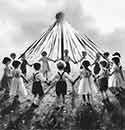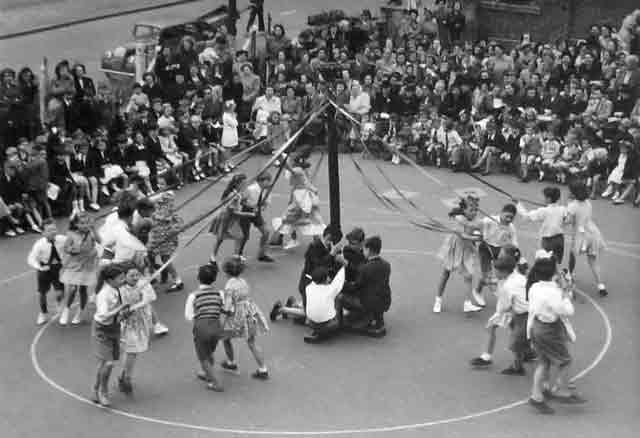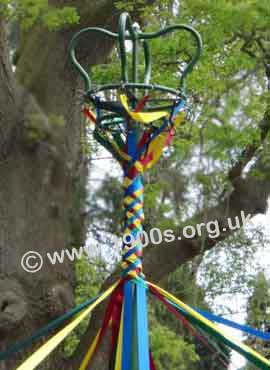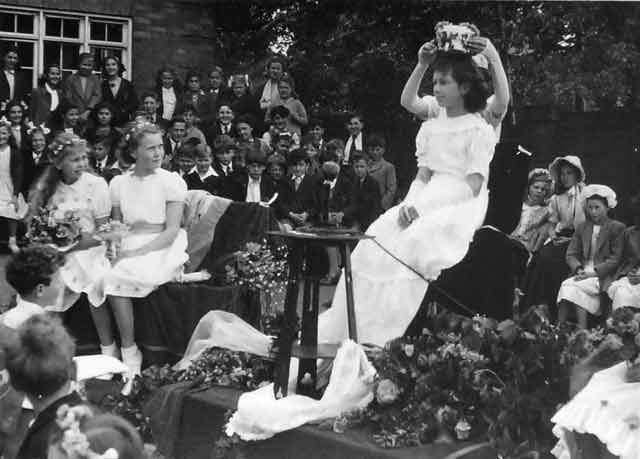May Day celebrations, early-mid 20th century UK

May Day, the 1st May, was widely celebrated in the past as the start of good summer weather with dancing round a maypole and crowning a May Queen. My school in the 1940s managed to celebrate in the traditional manner, in spite of the austerity of wartime UK and the years immediately afterwards,. This page describes a maypole and my May Day experiences at the time and goes on to recall personal experiences in Victorian and Edwardian times.
____
By the webmaster's mother (1906-2002) from personal experiences/observations, with firsthand contributions from others, edited with further research by the webmaster
What was a maypole?
A maypole was - and of course still is - a tall vertical pole with long, wide coloured ribbons fastened to the top. Traditionally people held the ends of these ribbons and danced round the maypole weaving between one another and so weaving patterns round the pole.

Dancing round the maypole, mid 1940s, at Edgware Primary School, with parents invited to watch
Maypole dances
At my school, we had a maypole in the playground and we danced round it intertwining its ribbons. This was traditional and further down the page, my mother describes something similar from her Edwardian childhood.
Different dances produced different patterns, and the dancers had to move closer and closer to the pole, the more they danced because their ribbons became shorter. When the teacher thought that the ribbons were becoming too short, we children were told to dance the other way to unwind the ribbons. Sometimes this was to music.

Weave at the top of a maypole. Photographed at Tilney War/Peace festival. My school's maypole had a less elaborate wooden top.
Probably our maypole was an old one, so no significant costs could possibly have been involved in putting on the celebrations.
The May Queen and her ladies/attendants
Also traditional was a May Queen, and we had one at school along with her ladies in waiting. They were girls from the oldest classes. They wore fancy white dresses and had flowers in their hair. No doubt these dresses owed much to the sewing ingenuity of the girls' mothers, as clothing coupons would not have been spared for them.
During the celebrations, the May Queen was formally crowned by one of her ladies in waiting.

The crowning of the May Queen, mid-20th century.
The May Queen's name was Helen Kingston and her attendant on the far left was Brenda Mialls.
Recollections of being May Queen at school
contributed by Margaret Clayton (formerly Margaret Culley)
How the May Queen was chosen
Sometime before May Day, about six girls from my year were paraded around the classes, and the children in these classes voted for who they wanted to be May Queen. How the original group were chosen escapes me, or perhaps I never knew. The girls who came second and third were the Attendants, the May Queen's ladies in waiting. I was still hobbling around with one leg in plaster (after breaking my foot) so goodness knows how I won - sympathy vote perhaps!
The order of ceremonies at May Day
The event started with a procession around the playground with all the children lining the route! Then the May Queen and her attendants went up on to a raised stage where the Queen was crowned by the Queen from the previous year. Sally Porte was one of my attendants, but I don't remember who else. Miss Sturdy was the organiser.
After the crowning, I had to make a speech.
Then there was dancing round the maypole, with various classes taking part.
The invited audience
Parents were invited to come. So there was much applause for all those taking part.
May Day in Victorian and Edwardian times
My mother wrote what May Day was like in her and her mother's childhood. In fact it was almost identical to what I describe above, but my experience was in the austerity of the post-war years, so hers was more lavish.
Earlier experiences of May Day
A pleasant memory from my childhood in the early 1900s was May Day, the 1st of May. It was regarded as the beginning of good weather and it was widely celebrated.
Children in the early 1900s dancing round a maypole on May Day
On May Day the maypole came out of storage. It was a pole with twelve-or-so different coloured ribbons hanging from the top, and in good weather it was erected in the playground so that passers by could stop and admire the celebrations around it. In bad weather it was erected in the school hall.
School children were the maypole dancers, although I suppose that there must have been festive maypole dancing elsewhere with adults.
I loved to see it, but I never took part. My brother Jim did, and my mother made him a smock for the event, as worn by the old country yokels.
To add to the festive atmosphere, the horses in the streets often had nosegays of flowers platted into their harnesses. (Incidentally, quite generally in the summertime, horses would wear little straw ear covers. I suppose to keep off the flies.)
The origin of the maypole and May Day celebrations
The origin of the maypole and May Day celebrations is lost in history but historians seem to agree that they probably originated in Germany and spread to germanic countries: the maypole represented a tree and the celebrations were pagan. There is more speculation on Wikipedia.
| sources | webmaster | contact |
Text and images are copyright
If you can add anything to this page or provide a photo, please contact me.




